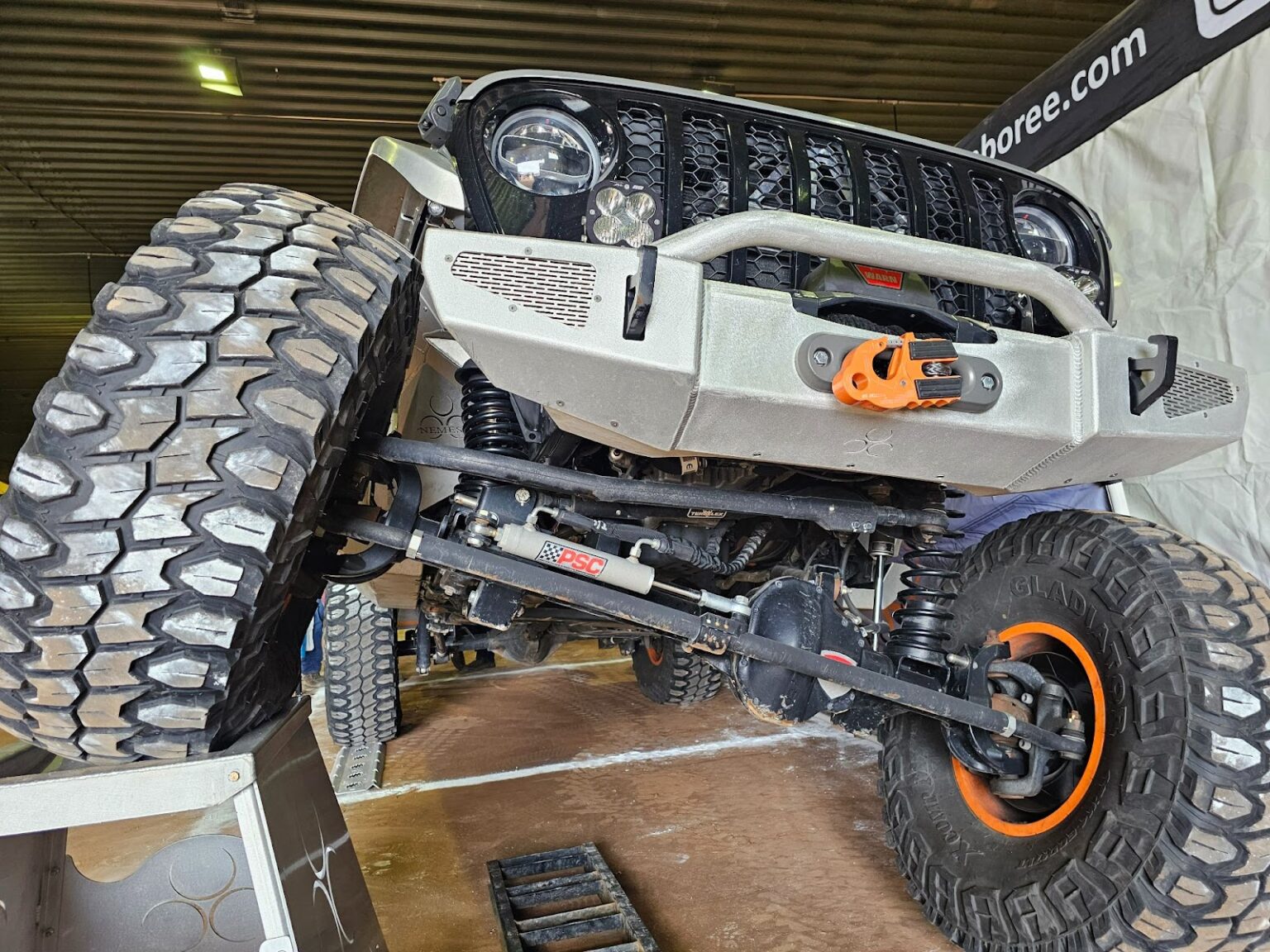There’s no doubt about it: the off-road industry is on the cusp of a significant technological transformation.
Thanks to increasing demand and growth in the off-road space, established companies and newcomers are offering better, more capable products and transformative digital technology. This includes everything from equipment that makes conquering the toughest off-road trails easier than ever to advanced, cloud-based systems that interface with smartphones and in-car systems to offer a better, safer way to get out into the field.
PDM Automotive recently attended the Easter Jeep Safari’s Vendor Showcase and had the opportunity to see some of the newest off-road technology in action. Along with seeing the best and brightest vendors, we also had the opportunity to see some of this equipment at work on the trails around the Moab Valley in beautiful Utah.
In no particular order, here are the seven predictions driving the future of the automotive aftermarket.
1. Rise of advanced off-road tech and equipment
Source: Jeep
The off-road sector stands on the brink of a transformative era characterized by the advent of advanced technologies designed to conquer extreme conditions with ease and safety.
This wave of innovation is expected to usher in smarter, more durable equipment, from high-performance vehicle modifications to wear-resistant gear, all aimed at enhancing the off-road experience. These technological advancements are not just about brute strength or endurance; they also bring intelligent features like adaptive terrain response systems, energy-efficient powertrains for electric off-road vehicles, and advanced materials that offer superior protection while reducing weight.
This new generation of technology promises to redefine the boundaries of off-road adventure, making it more accessible, enjoyable, and environmentally friendly. Enthusiasts can look forward to vehicles and gear that are more capable and smarter, with embedded systems that can adjust to varying off-road conditions in real time, offering a safer and more immersive experience.
2. Customization and personalization at scale
The future of off-roading is not just about advancing technology; it’s about creating a deeply personalized experience for every enthusiast.
As we look ahead, the prediction is clear: personalization in the off-road sector will scale new heights, becoming more refined, accessible, and integral to the off-road experience. Off-roaders are not a monolithic group; they have diverse interests, vehicles, and definitions of adventure. Recognizing this, the industry is moving towards offering equipment and solutions that can be tailored not just to the specifications of the vehicle but to the unique preferences and styles of the individual behind the wheel.
In this new era, personalization extends beyond choosing colors or accessories; it involves custom-engineered modifications that enhance performance, comfort, and safety according to each enthusiast’s specific requirements. Whether it’s a suspension kit designed for the vehicle’s specific weight distribution and use case or an off-road navigation system that learns from your driving habits to suggest routes, the future promises a level of customization previously unseen.
This shift towards personalization will be powered by advances in manufacturing technology, such as 3D printing and AI-driven design, allowing for cost-effective customization at scale.
3. Sustainability and eco-conscious products
Source: Jeep
Amidst growing environmental concerns and a heightened awareness of our ecological footprint, a significant shift towards sustainable and eco-friendly off-road products is not just anticipated; it’s already underway.
This movement is driven by regulatory pressures and a changing consumer ethos, with a growing segment of the off-road community seeking ways to reconcile their passion for adventure with their commitment to environmental stewardship. This green revolution encompasses a wide array of innovations and initiatives to reduce the environmental impact of off-roading.
From vehicles powered by alternative energy sources to biodegradable lubricants and recyclable materials, the industry is exploring every avenue to ensure that the thrill of off-roading can coexist with ecological responsibility. Once a novelty, electric off-road vehicles are poised to become mainstream, offering a zero-emission alternative to traditional combustion engines without compromising performance or durability.
Manufacturers using advanced materials and manufacturing techniques promise to reduce the weight, increase the efficiency of off-road equipment, and minimize waste and energy consumption throughout the product lifecycle. Sustainable sourcing and supply chain practices are becoming a priority, with manufacturers increasingly favoring materials and components that are ethically produced and environmentally friendly.
4. Integration of IoT and connectivity
Source: onX
In the world of off-roading, the integration of the Internet of Things (IoT) and advanced connectivity is set to redefine the relationship between vehicles, their environment, and the adventurers who pilot them.
The prediction that off-road vehicles and equipment will increasingly incorporate IoT technologies speaks to a future where enhanced connectivity transforms navigation, safety, and performance monitoring into a seamless, interactive experience.
Imagine venturing into the wild unknown, where every trail and path holds challenges. Now, picture your vehicle as your guide, equipped with IoT-enabled navigation systems that do more than just point directions; they provide real-time data on terrain conditions, weather forecasts, and route difficulty. Companies like onX are already creating and expanding on this technology.
Safety and Security
Safety in off-roading is paramount, and IoT technologies are set to revolutionize how adventurers manage risks.
Vehicles equipped with sensors and connectivity can monitor critical systems in real-time, alerting drivers to potential issues before they become dangerous. For instance, tire pressure monitors could automatically adjust to terrain changes, enhancing grip and stability on varying surfaces. In an emergency, vehicles could automatically send alerts to rescue services, providing precise location data to expedite assistance.
This ecosystem of connected safety features promises to significantly reduce the risks associated with off-road adventures, giving enthusiasts peace of mind as they explore.
Performance Monitoring and Enhancement
The heart of off-roading lies in the vehicle’s performance, where IoT technologies are poised to make a substantial impact. With the integration of performance monitoring systems, enthusiasts can gain insights into their vehicle’s operation like never before. Real-time data on engine health, fuel efficiency, and component wear can be analyzed to optimize performance and prevent breakdowns.
This data can be used to customize the vehicle’s settings to suit specific terrains and driving styles, from adjusting suspension stiffness for rocky paths to modifying engine mappings for better fuel efficiency on long treks.
5. Virtual interaction with real-world applications
AR technology enables consumers to visualize off-road equipment in a real-world context, allowing them to see how a roof rack looks on their vehicle or how a new set of tires fits, all through the screen of their smartphone or AR glasses.
This level of interaction goes beyond simple visualization; it includes detailed, interactive models that can be customized and examined from every angle. Consumers can explore the features, understand the installation process, and even simulate the performance of products under various conditions, providing a comprehensive understanding of the product’s value and applicability to their needs.
AR extends its utility to educational content, offering immersive tutorials and guides that can assist consumers in installation or troubleshooting common issues. This hands-on approach enhances consumer confidence in their purchasing decisions and enriches their knowledge and skills, fostering a deeper connection between the brand and its audience.
6. Growth in off-road experiential retail
Retailers will create immersive, experience-driven shopping environments, both online and offline, where customers can deeply engage with off-road culture and products, suggesting a significant evolution in the retail industry, particularly in the niche of off-road gear and experiences.
Online immersive experiences
Retailers might develop VR platforms allowing customers to experience off-road environments virtually from their homes. Imagine “test driving” off-road vehicles or experiencing how specific gear performs in various terrains and weather conditions through a VR headset.
AR technology could let customers see how off-road gear and equipment would look and fit in real-world settings. For instance, an AR app can visualize how a roof rack would look on a vehicle or how camping gear would fit into its space.
Retailers could offer online tools that allow customers to customize their off-road vehicles or gear, changing features, colors, and accessories in real time and seeing how these customizations affect performance in different off-road scenarios.
Offline immersive experiences
Beyond traditional retail spaces, we might see the rise of experience centers where customers can physically test off-road vehicles and gear. These centers could feature simulated terrains, like sand, rocks, and mud, allowing customers to feel the product’s performance to help cement a decision.
Retailers could host events and workshops that foster a sense of community among off-road enthusiasts. These include off-road driving classes, gear repair workshops, or meet-ups for off-road adventure planning. In another evolution of this concept, retailers may partner with off-road adventure parks to offer customers exclusive experiences or trials of new products. This would allow for real-world testing of gear and strengthen the community aspect of off-road culture.
7. Evolving overlanding adventures
Source: Oregon Adventure Vehicles
Overlanding, which combines off-road driving with self-reliant travel to remote destinations, has gained momentum as individuals seek to escape the hustle and bustle of urban life and connect with nature more profoundly.
Growth in overlanding popularity
As digital fatigue becomes more prevalent, more people will seek ways to disconnect from technology and immerse themselves in nature. Overlanding offers an ideal blend of adventure, travel, and disconnection from the digital world, appealing to those looking for a break from their screens.
There is a growing cultural shift towards valuing experiences over possessions, particularly among younger generations. Overlanding adventures offer unique experiences that can’t be replicated, making them increasingly attractive to those seeking adventure and personal growth.
Seeking remote and challenging adventures
Enthusiasts will increasingly seek out remote destinations that offer beauty and a sense of achievement in reaching them. These might include untouched natural landscapes, ancient ruins, or locations known for their extreme conditions.
There will be a trend towards more challenging adventures, where the journey itself tests the limits of both the vehicles and the individuals. This could involve navigating through harsh terrains, enduring extreme weather conditions, or undertaking long-duration trips that test self-reliance and survival skills.
Driving demand for specialized equipment
As enthusiasts push further into remote areas, the demand for specialized vehicle modifications will grow. This includes advanced suspension systems, durable off-road tires, high-capacity fuel tanks for extended range, and specialized recovery equipment for self-rescue in isolated areas.
Reliable navigation and communication tools will become paramount, especially for safety in remote locations. Satellite phones, GPS devices with off-grid maps, and emergency beacon systems will become standard equipment for serious overlanders.
With an emphasis on minimizing environmental impact and enhancing self-sufficiency, there will be a surge in demand for sustainable gear, solar power systems, water purification systems, and compact, energy-efficient appliances designed for off-grid living.
Efficient use of space is crucial in overlanding. Customized storage solutions that optimize vehicle space for gear, food, and personal belongings while ensuring easy access and organization will be in high demand.
Empower off-road innovation with PDM: the ultimate product information management solution
In the rapidly evolving off-road industry, where the demand for cutting-edge, personalized, and sustainable products is at an all-time high, standing out requires quality products and the ability to deliver them to market with unmatched efficiency and accuracy. This is where PDM Automotive comes into play, offering an unparalleled Product Information Management (PIM) solution tailored to off-road product manufacturers’ unique challenges and opportunities.
Why choose PDM to manage your off-road products portfolio?
Centralized Data Management: PDM serves as your single source of truth, centralizing all product information, from technical specifications to marketing copy. This ensures consistency across all channels, enhancing brand reliability and customer trust.
Streamlined Product Launches: With PDM, speed and accuracy in bringing new innovations to market are significantly improved. By efficiently managing complex automotive product data, PDM enables faster product development cycles and quicker response times to market trends.
Enhanced Customer Experience: PDM’s robust data capabilities support advanced customization and personalization at scale. It empowers aftermarket manufacturers to meet the growing demand for products tailored to individual off-roader’s preferences, enhancing customer satisfaction and loyalty.
Facilitation of Global Expansion: With its ability to manage and localize product information for different markets, PDM is an essential tool for manufacturers looking to expand their reach globally, ensuring that product data meets each market’s linguistic and regulatory needs.
As an off-road product manufacturer, the time to elevate your product data management is now. PDM offers a strategic advantage, enabling you to navigate the complexities of today’s market with confidence and agility. By choosing PDM as your PIM solution, you’re not just investing in a tool; you’re setting the foundation for future growth, innovation, and customer satisfaction.
Embrace the future of off-road product management with PDM. Book a personalized demo to learn how our PIM solution can transform your product data management, streamline your operations, and connect you with your customers in more meaningful ways.
More Resources
Elevate Your Brand in the Automotive Aftermarket With These Content Management Strategies



